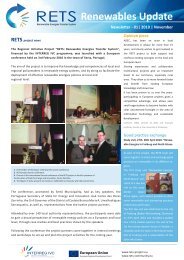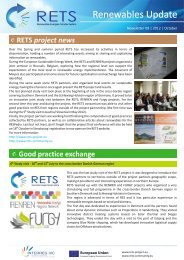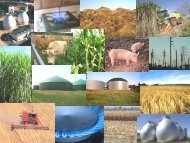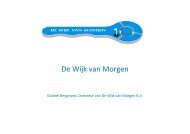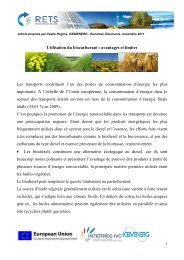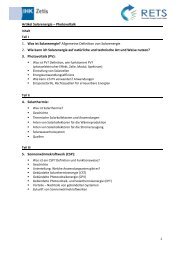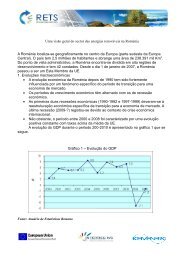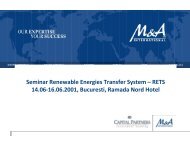Anatomy of a Small Scale Hydropower system - RETS Project
Anatomy of a Small Scale Hydropower system - RETS Project
Anatomy of a Small Scale Hydropower system - RETS Project
Create successful ePaper yourself
Turn your PDF publications into a flip-book with our unique Google optimized e-Paper software.
<strong>Anatomy</strong> <strong>of</strong> a <strong>Small</strong> <strong>Scale</strong> <strong>Hydropower</strong> <strong>system</strong><br />
Article submitted by N Packer, Staffordshire University, UK, June 2011.<br />
Overview<br />
Solar energy evaporates seawater producing clouds and, when droplets attain enough mass, gravity<br />
attracts the water back to the ocean as rain. Alternatively if this rain falls over high ground and is<br />
channelled into fast moving rivers and streams we have the opportunity to extract some <strong>of</strong> its<br />
energy by separating some <strong>of</strong> the flow for passage through water turbine/generator sets to produce<br />
electricity.<br />
Definitions vary but small-scale hydropower can be sub-divided into mini (
From the forebay the water enters a pipe (5), commonly called the ‘penstock’, to commence the<br />
final leg <strong>of</strong> its journey down to the hydro-turbine. If a site has difficult topography or is<br />
environmentally sensitive the canal is sometimes omitted and an extended penstock carries water<br />
from the river bifurcation direct to the powerhouse.<br />
The hydro-turbine and electrical generator are housed in the powerhouse (6).<br />
[In a barrage scheme arrangement the headrace and penstock are dispensed with and the<br />
powerhouse is effectively in-line with the river or stream.]<br />
After passage through the turbine the water is returned to the river or stream via a calming channel<br />
(7) known as the ‘tailrace’.<br />
Power and Energy output<br />
The two most important parameters associated with the power output <strong>of</strong> a hydropower <strong>system</strong> are<br />
flow and head. The flow is the volumetric passage <strong>of</strong> water Q(m 3 /s) through the turbine and the<br />
head H(m) is the vertical distance the water travels from supply point (i.e. the penstock entry) to<br />
turbine discharge.<br />
Hydro-turbines are reasonably efficient fluid power to mechanical (rotating shaft) power converters<br />
having efficiencies in the range 70 – 90%. Overall efficiency will depend on the electrical generator<br />
efficiency but values in the range 50 – 70% are common.<br />
For the purposes <strong>of</strong> illustrating the influence <strong>of</strong> head and flow, a simplified expression for the design<br />
electrical power output P(kW e ) <strong>of</strong> a hydropower plant operating at an overall efficiency <strong>of</strong> 60%<br />
efficiency would be:<br />
P = 5.9 x Q x H (kW e )<br />
Clearly maximising the head (H) and design flow rate (Q) maximises the power output and energy<br />
generated.<br />
To maximise energy capture at times <strong>of</strong> reduced river flow, most hydro-turbines are able to operate<br />
at flow rates below their design value. The power output will, at these times, be below the design<br />
discussed above. An estimate <strong>of</strong> the annual energy output will then depend on an ‘equivalent’ full<br />
power output over the year. This variation is taken care <strong>of</strong> by parameter called the capacity factor.<br />
Capacity factors for hydro plants tend to be in the range 40-70%.<br />
Using the above example, for a hydro-turbine with a capacity factor <strong>of</strong> 55% the estimated annual<br />
electrical energy output E (kWh e /annum) would be:<br />
E = 5.9 x Q x H x 0.55 x 8760<br />
= 28426 x Q x H (kWh e /annum)
Final thoughts<br />
Head is more or less fixed and is best determined by onsite measurement or less accurately, for<br />
preliminary feasibility studies, by topographical mapping.<br />
The available flow rate through the turbine on the other hand is a variable dependant on a range <strong>of</strong><br />
factors.<br />
Hydrographs (flow versus time) and flow duration curves (flow versus percentiles or time exceeded)<br />
are commonly used to determine the ‘flashiness’ (flow variability) <strong>of</strong> a river or stream.<br />
Above all, the fraction <strong>of</strong> flow diverted for energy generation must not leave the depleted region<br />
(‘reach’) <strong>of</strong> the river ecologically damaged and consequently extensive local hydrological and<br />
biological studies should be carried out prior to scheme sizing.<br />
Units & Abbreviations<br />
Volume: m 3 – cubic metres Volume flow rate: Q – m 3 /s Note 1m 3 = 1000litres<br />
Head: metres (a vertical distance)<br />
Energy: kWh (kilowatt-hour)<br />
Power: W – Watt kW (kilowatts) – thousands <strong>of</strong> watts MW (Megawatts) – millions <strong>of</strong> watts<br />
Further suggested reading and research<br />
A Beginner’s Guide to Energy and Power, N Packer, Staffordshire University, UK<br />
<strong>RETS</strong> articles, February 2011.<br />
www.esha.be<br />
www.microhydropower.net<br />
www.british-hydro.org<br />
www.cat.org.uk<br />
www.environment-agency.gov.uk
Neil Packer is a Chartered engineer and Senior lecturer at the Faculty <strong>of</strong> Computing, Engineering and<br />
Technology, Staffordshire University, UK. He has been teaching thermo-fluid and environmental engineering<br />
for nearly 20 years and acts as a Low Carbon Consultant providing a range <strong>of</strong> energy services to business,<br />
industry and local authorities.<br />
Contact details:<br />
Faculty <strong>of</strong> Computing, Engineering and Technology<br />
Staffordshire University<br />
Beaconside, Stafford, ST18 0AD<br />
Tel 01785 353243 email n.packer@staffs.ac.uk<br />
This information was presented as part <strong>of</strong> the Renewable Energies Transfer System <strong>Project</strong> (<strong>RETS</strong>) funded by<br />
INTERREG IVC through the European Regional Development Fund. The project time line is January 2010 to<br />
December 2012. For more information and to take part in our online community visit: http://www.retscommunity.eu/




